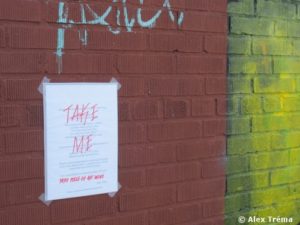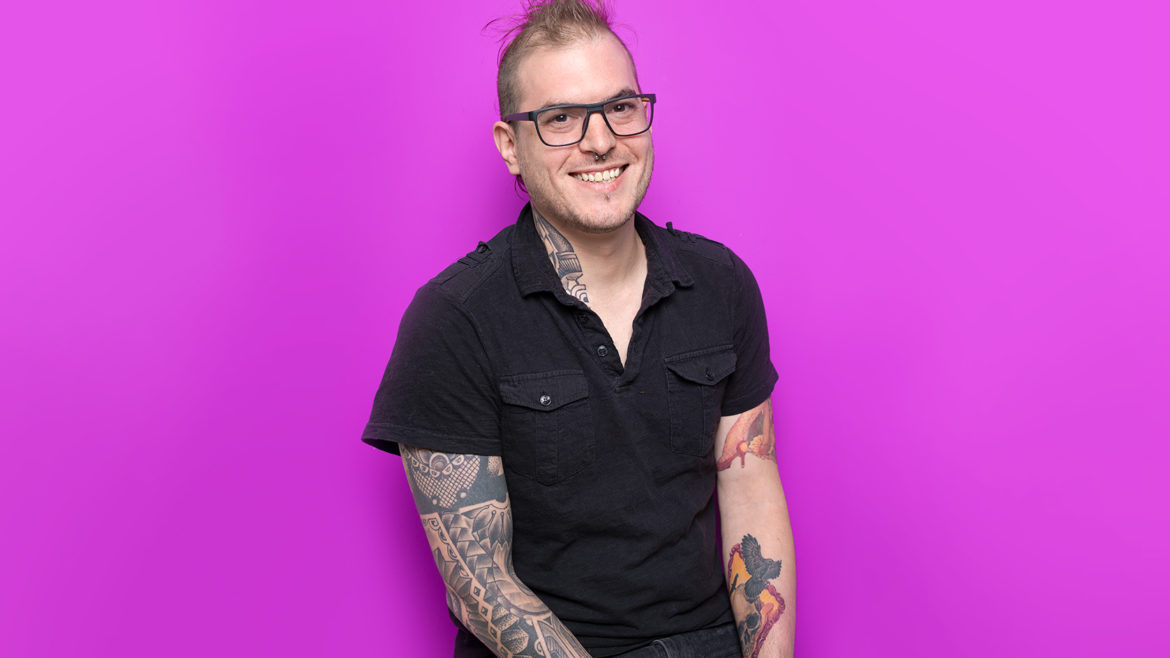Whilst Alexandre Guénon may be well known at Altavia Paris as DM Purchasing Manager, he is perhaps a little less well known by his artist name, Alex Tréma – an urban stencil artist who has made quite a name for himself on the street art scene over the past 7 years. We had a chat with this generous globe-trotter who gives his art away on the streets to anyone who cares to look past the ends of their noses.
How did you get into urban stencil art?

“Art Is Me / Dali”, big size artwork by Alex Tréma
I’ve always done some kind of art, alongside my work, from designing and even, in some cases, producing furniture right through to painting. I’ve always had a bit of a thing for urban art, and I discovered the pochoir technique seven years ago.
Every other year I take my son abroad for his birthday to explore a new city. For his14th birthday we went to Berlin. I had booked a street art tour and the first stop was at a pochoir workshop, which I really enjoyed.
Around the same time, I had also treated myself to a piece by Lille-based artist Mimi The Clown for my 40th. We got to know one another and kept in touch, so when I told him about my encounter with urban stencil art he asked “why don’t you give it a go?”. I immediately brushed the idea off, convinced that I wouldn’t get anywhere with it. “What’s the worst that can happen?”, he asked. “If it goes wrong, you cover it over and you start again”. His words really struck a chord with me and gave me the freedom I needed.
What do you like so much about this art?
It’s quite an accessible technique: you can choose to create a text or face using just one colour and even that will have an interesting effect. Then, of course, there is the fact that you only get to see the end result when it’s too late, once all the stencils have been cut out and painted, and I really like that element too.
So on your return from Berlin, and on the advice of Mimi The Clown, you decided to focus your efforts on urban pochoir, or stencil art…
When my son was at secondary school I used to drop him off on a Saturday morning and go off and apply my stencils around the local area. That was it – I had the bug, and I was starting to get recognised a bit in the area. Eight months later, in May 2013, I launched the Take Me project in New York, which added a new dimension to the idea of simply painting and sticking things around the streets.
Tell us about the concept behind the Take Me project

Picture of Alex Tréma’s New-York “Take Me” project
I start by creating an original 24x32cm painting using a stencil. I make 24 versions of it using the same stencil but with a different background colour. I put each one in a tracing paper envelope with ‘Take Me’ written on it, and I tape each one to a wall, public bench, lamppost etc. out in the street so that anyone passing by can find them and keep one as a memento. All I ask in return, if they want, is that they send me a photo of the piece they’ve found in the setting of their choice.
I launched Take Me in New York, thinking it would be a unique experiment. Over the course of 9 days, I would leave pieces here and there as I travelled around the city. On the first day I got an email from a young woman who was a fan of urban art and was thrilled to have found one of my pieces. By the time I left, I had received feedback on 8 of the 24 pieces I had dotted around. Once I got back to Paris I was really keen to repeat the experiment.
And you have continued to travel with your art ever since
I’ve given away some 800 pieces out on the streets since May 2013 and have received 180 emails in return. I’ve visited 25 cities in 13 countries on 3 continents. I actually got news about one piece 4 years after the Barcelona edition, not to mention one piece that was found in Paris and taken back and photographed in Melbourne, Australia. Some of the pieces get destroyed by the weather, whilst people might just take a dislike to others and throw them away, but that’s all part of the project.
The last place the Take Me project took me to was La Rochelle, where I travelled 36km in two and a half days!
And there have even been two collective versions – Take Us
I actually decided to invite a number of renowned artists who I really admire, such as Speedy Graphito, who produced a piece valued at €1,500, to get on board with me to mark the project’s 1st and 5th anniversaries. I also got in touch with the great, now-92-year-old artist Jacques Villeglé, the man behind the Affichiste poster movement, and he donated 22 pieces to the 5-year anniversary project. CharlElie Couture also got involved, joining the other big-name artists who appreciated the very simple nature of the project and its ability to reach out to people.
Which is the next city you’ll be targeting with your creations?
I’m heading to Madrid in the autumn! As well as the Take Me project, I am also president of the PARTcours urban art association, which I founded with Raf Urban and hRLck in June 2018. Together with 25 other artists we took over a gym last December and our work was seen by some 3,700 art-lovers during the 22 hours it was open. Our next project, in October 2019, will see us working at a primary school in Joinville-le-Pont. Maybe we’ll see you there?



